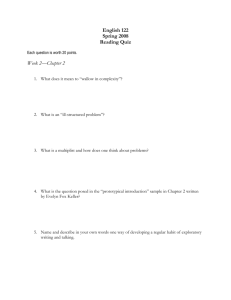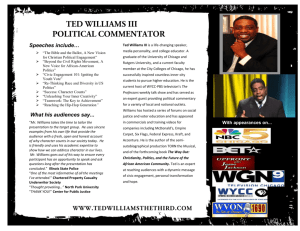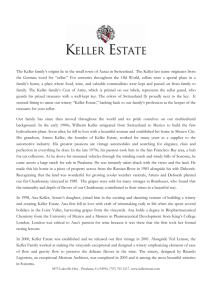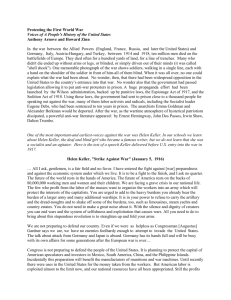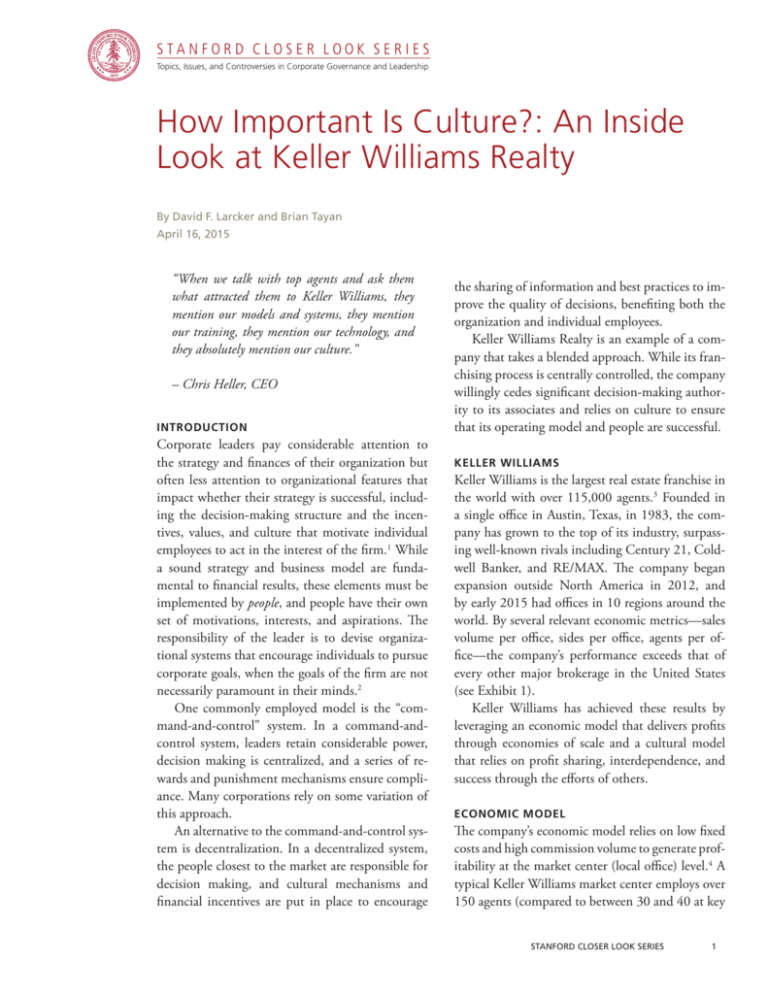
STANFORD CLOSER LOOK SERIES
Topics, Issues, and Controversies in Corporate Governance and Leadership
How Important Is Culture?: An Inside
Look at Keller Williams Realty
By David F. Larcker and Brian Tayan
April 16, 2015
“When we talk with top agents and ask them
what attracted them to Keller Williams, they
mention our models and systems, they mention
our training, they mention our technology, and
they absolutely mention our culture.”
– Chris Heller, CEO
introduction
Corporate leaders pay considerable attention to
the strategy and finances of their organization but
often less attention to organizational features that
impact whether their strategy is successful, including the decision-making structure and the incentives, values, and culture that motivate individual
employees to act in the interest of the firm.1 While
a sound strategy and business model are fundamental to financial results, these elements must be
implemented by people, and people have their own
set of motivations, interests, and aspirations. The
responsibility of the leader is to devise organizational systems that encourage individuals to pursue
corporate goals, when the goals of the firm are not
necessarily paramount in their minds.2
One commonly employed model is the “command-and-control” system. In a command-andcontrol system, leaders retain considerable power,
decision making is centralized, and a series of rewards and punishment mechanisms ensure compliance. Many corporations rely on some variation of
this approach.
An alternative to the command-and-control system is decentralization. In a decentralized system,
the people closest to the market are responsible for
decision making, and cultural mechanisms and
financial incentives are put in place to encourage
the sharing of information and best practices to improve the quality of decisions, benefiting both the
organization and individual employees.
Keller Williams Realty is an example of a company that takes a blended approach. While its franchising process is centrally controlled, the company
willingly cedes significant decision-making authority to its associates and relies on culture to ensure
that its operating model and people are successful.
Keller Williams
Keller Williams is the largest real estate franchise in
the world with over 115,000 agents.3 Founded in
a single office in Austin, Texas, in 1983, the company has grown to the top of its industry, surpassing well-known rivals including Century 21, Coldwell Banker, and RE/MAX. The company began
expansion outside North America in 2012, and
by early 2015 had offices in 10 regions around the
world. By several relevant economic metrics—sales
volume per office, sides per office, agents per office—the company’s performance exceeds that of
every other major brokerage in the United States
(see Exhibit 1).
Keller Williams has achieved these results by
leveraging an economic model that delivers profits
through economies of scale and a cultural model
that relies on profit sharing, interdependence, and
success through the efforts of others.
economic model
The company’s economic model relies on low fixed
costs and high commission volume to generate profitability at the market center (local office) level.4 A
typical Keller Williams market center employs over
150 agents (compared to between 30 and 40 at key
stanford closer look series
1
how important is culture?: an inside look at keller williams realty
competitors) and generates more than twice the
sales volume. The franchise headquarters is careful
to approve franchises with large territories to maximize profitability for the office and its agents. With
fewer offices in a market, commission revenue is
divided across a lower fixed-cost base, thereby increasing profitability. In 2014, 98 percent of Keller
Williams market centers open at least a year were
profitable.
The commission split is a hybrid of that offered
by various competitors and is designed to share
the benefits of production equitably between the
market center and agents.5 A Keller Williams agent
generally receives a 70/30 commission split from
the first dollar of gross commission income (GCI)
generated from the sale of a home. The agent splits
commissions with the market center at this rate until reaching an annual cap. The cap is determined by
the owner of the market center at the time the center is opened and typically ranges between $20,000
and $60,000, depending on the market. The agent
retains all GCI in excess of the cap. The agent is also
responsible for paying a small franchise fee to the
international office each year.
Keller Williams is unique among real estate
franchise companies in that it offers a second
source of income—profit sharing—to its agents.
The formula for distributing profits is based on the
productivity of other agents that the agent recruits
to the company and the cash profits generated by
their market center. It takes into account not only
agents directly recruited (so-called “level one” profit
sharing) but also agents that those agents recruit,
extending up to seven degrees of separation, and is
designed to reward the recruitment of highly productive agents. The international office calculates
each agent’s profit share based on financial reports
transmitted monthly by the market centers.6 In
2014, Keller Williams shared $98 million in profits
with its agents (see Exhibit 2).
The combination of the Keller Williams economic model and profit sharing system results in
an economic profile that is very different from competitive firms (see Exhibit 3). Agents retain a higher
percentage of GCI (approximately 82 percent versus 66 percent). Market centers have a lower operating margin (5 percent versus 8 percent), and the
international office receives a lower effective royalty
rate (3 percent versus 6 percent). However, because
each market center tends to be much larger than
those of competitors, the dollar amounts flowing
to the owners of market centers and to the international office are higher. Less money is spent on
expenses (7 percent versus 20 percent). The economic system is designed to be consistent with the
company’s “win-win” philosophy.
Cultural Model
To the leaders of the company, Keller Williams’ culture is equal in importance to the economic model
in accounting for the company’s success. According to former president and current board member Mary Tennant, “We know for a fact that our
systems don’t work without our culture. We need
our culture to reach our full potential.” According
to Vice Chairman Mo Anderson, the culture is “the
glue that holds it all together.” In the words of a
former executive, “It’s very difficult to separate the
culture and the systems, because the systems are
written for the culture and the culture exists for the
systems.”7
The company’s culture encourages interdependent relationships and achieving success through
the efforts of others.8 It is encapsulated in the company’s belief system: WI4C2TS (pronounced “why
four see two tees”):
•
•
•
•
•
•
•
•
•
Win-win – or no deal
Integrity – do the right thing
Customers – always come first
Commitment – in all things
Communication – seek first to understand
Creativity – ideas before results
Teamwork – together everyone achieves more
Trust – starts with honesty
Success – results through people
The company maintains four cultural practices to ensure that agents, market center owners, and team leaders operate like real stakeholders in the company. First,
the company shares its profits, as discussed above. Second, the company involves agents, owners, and team
leaders in decision making. Third, the company maintains open financial books. Fourth, the company offers extensive training to agents and leaders.
stanford closer look series
2
how important is culture?: an inside look at keller williams realty
Decision making.
The organizational structure of
each market center encourages shared decision
making among owners, leaders, and agents. The
Keller Williams franchise agreement requires a
separation between the ownership of a market center and its leadership. Market centers are owned
by an operating principal (OP) but managed by a
team leader whom the OP recruits. This structure
gives the team leader accountability. It also means
the OP and team leader have aligned incentives;
whereas the OP is principally concerned with maximizing owner profits, the team leader makes money
primarily through an operating profit bonus that
depends on profitability. The OP recruits a core of
top-performing agents to launch the office. These
agents become the bedrock of the market center
and help the team leader attract additional agents.
The team leader’s responsibility is to grow agent
count, and the profit sharing system gives an additional incentive to do so.
The management of the market center is not the
sole responsibility of the team leader, nor is it the
joint responsibility of the OP and the team leader.
Keller Williams believes that agents are stakeholders in the success of the market center and therefore
should share in decision making. As a result, the
OP, team leader, and select agents (chosen among
the top 20 percent measured by GCI) jointly serve
on what is called the Agent Leadership Council
(ALC). Together, they jointly make office decisions relating to financial planning, recruiting and
retention, marketing and advertising, training,
technology, social events, and philanthropic giving. The ALC structure has the following benefits:
those with local knowledge and the greatest financial stake in the market center help make decisions;
agents learn a business mentality with special attention to cost control; shared authority leads to
better retention; and policies have greater validity
throughout the market center because they have
been set by peers. According to former CEO and
current board member Mark Willis, “We empower
our people to make decisions that they literally own
and are accountable for, because they have been given a voice. They’ve been treated like partners and
they’ve been respected.”9 In the words of a team
leader, “We have a saying, ‘As the ALC goes, so goes
the market center.’ We’re an agent-driven company.
Any time we’ve gotten in trouble it is because we
didn’t slow down, help to explain [our choices], and
get everybody’s buy-in.”10
Bottom-up decision making extends to the
executive leadership of the company. CEO Chris
Heller and President John Davis both were successful agents, owners, and regional leaders for the
company before assuming their current roles.
Open books.
In order for the profit share and ALC
decision-making systems to maintain their integrity, Keller Williams operates an open books policy.
All agents in the market center have access to view
detailed revenue and expense information for the
entire market center to help increase the market
center’s profit and profit share. Because the profit
share formula does not change, agents can run calculations to make sure they are receiving the correct
amount. Minutes of ALC meetings are also available for review. The open book system means that
there are no secrets between the leaders of the market center and individual agents regarding financial
or managerial decisions.11
Training.
Finally, the leaders of Keller Williams believe that if individuals are expected to play a role
in the management and success of the company,
the company has an obligation to provide education and training to help them reach their full potential. Keller Williams offers extensive training to
agents, team leaders, and OPs through courses that
document best practices for business building, leadership, and personal development. These include
instructor-led classroom courses, instructor-led
virtual sessions, and online self-paced modules. In
2014, 100,000 associates and affiliates completed
classroom-based sessions, and 26,000 associates
completed online self-paced study programs. Training magazine ranked Keller Williams number one
on its 2015 list of the top 125 companies providing
learning and development for employees, across all
industries.12
The Keller Williams operating model results in
an organization that is essentially agent led. All major initiatives are originated in the field, and agent
initiatives are implemented in a market center only
stanford closer look series
3
how important is culture?: an inside look at keller williams realty
with the buy-in of associates. For example, recent
initiatives to boost market center profitability and
agent count, charitable activities, the company’s
expansion into specialty lines, and the adoption of
new technology were all initially devised by individual associates before adoption by other market
centers.
Furthermore, all Keller Williams’ training courses are created by and modeled on the successful activities of individual agents, team leaders, and owners. For example, BOLD, an agent coaching class
designed to improve sales productivity, is based on
the systems and business practices that KW MAPS
Coaching CEO Dianna Kokoszka developed when
she was an agent. Kokoszka now leads the course
company-wide, and agents enrolled in BOLD average more transactions during the seven-week course
(13) than a typical agent in the industry averages
during a year (9).
Similarly, the Growth Initiative, a training and
accountability program for local and regional leaders, was developed by John Davis when he was a regional director to improve the profitability of market centers in his area. The Growth Initiative was
presented as an opt-in program and has now been
embraced companywide. The company’s leadership
attributes much of Keller Williams’ growth over the
last four years to adoption of tools developed and
refined through the Growth Initiative.
According to Bryon Ellington, chief learning officer of Keller Williams, “There is a level of cooperation between agents and offices that doesn’t exist
at other companies. Our training, our systems, the
profit share: it creates a virtuous cycle. And it all
ties back to this culture of giving back, of sharing
knowledge.”13
Why This Matters
1.Corporate leaders pay considerable attention to
their strategy and business model but somewhat
less attention to the culture of the organization.
How important is culture as a determinant of
economic outcomes? Are there industries or settings where culture is more important and others
where it is less important?
2.The leaders of Keller Williams believe that the
company’s economic model would not succeed
without its culture and that its culture could not
exist without its economic systems. Is this true?
Could a new culture be introduced without
compromising economic results?
3.The Keller Williams operating model has several unique features, including scale economies,
profit sharing, shared leadership, open financial
books, and training. How important are each of
these to the company’s success? Are some “more
important” than others?
4.The Keller Williams belief system places considerable emphasis on specific values and individual
behaviors. What impact do values and behaviors
have on economic outcomes? How are values
and behaviors within an organization influenced
by “tone at the top”?
5.Some economists believe that culture is simply a
reflection of the incentives (financial and nonfinancial) in place in an organization. Is this true?
Are culture and incentives the same, or is culture
something more than “incentives”?
To this end, a 2013 survey found that boards of directors do not
pay close attention to personnel-related issues such as mentoring and
developing talent, listening skills, and conflict management when
evaluating the performance of CEOs. See: The Miles Group and
the Rock Center for Corporate Governance at Stanford University,
“2013 CEO Performance Evaluation Survey,” (2013).
2
Economists refer to this problem as the “agency problem.”
3
For more on this topic, see: James N. Baron and Brian Tayan, “Keller
Williams Realty (A),” Stanford GSB Case No. HR-29A (April 12,
2007); and James N. Baron, David F. Larcker, and Brian Tayan,
“Keller Williams Realty (B),” Stanford GSB Case No. HR-29B (February 15, 2011).
4
The company refers to local offices or brokerages as “market centers,”
the owners of market centers as “operating principals,” and the individuals who lead the market centers as “team leaders.”
5
Traditional brokers offer a 60/40 split. “Rent-a-desk” firms offer a
100 percent commission split and charge a fixed monthly expense.
6
Detailed monthly reporting also gives the international office access
to better information about productivity and local market conditions than competitors have access to. Most real estate offices do not
share detailed monthly profit and loss statements with their franchisor.
7
This line of thinking has roots in academic theory. According to
Kreps (1990), an organization’s reputation is formed on the basis
of how it responds to unforeseen contingencies. If an organization
responds positively, it will improve its reputation in the eyes of employees (and potential employees); if it responds in a negative manner, it will detract from its reputation. Each positive action increases
the amount of faith that an employee has in the organization and
encourages performance that might not otherwise take place. An
organization that wishes to protect a positive reputation will apply
its principles “even when its application might not be optimal in
the short run” and “even in areas where it serves no direct organizational objective if doing so helps preserve or clarify” its principles.
See: David M. Kreps, “Corporate Culture and Economic Theory,”
1
stanford closer look series
4
how important is culture?: an inside look at keller williams realty
Chapter 4 in James E. Alt and Kenneth A. Shepsle (Editors), Perspectives on Positive Political Economy (Cambridge University Press,
1990). Quotes from: Keller Williams Realty (A), loc. cit.
8
Keller Williams’ culture is also reflected in the charitable activity of
its associates. The company’s charitable 501(c)(3) organization—
KW Cares—helps associates and their family members enduring
unexpected hardships including medical emergencies and natural
disasters. For example, after Hurricane Katrina, KW Cares raised
$5.3 million from Keller Williams offices nationwide to support
more than 700 associates who were displaced by the catastrophe;
by comparison, the National Association of REALTORS with more
than 1.2 million members raised $5.8 million. KW Cares originated
at the market center level before being adopted company-wide. The
company also maintains a global day of service—RED Day (“Renew, Energize, and Donate”)—on which associates close their offices
to volunteer in their local communities. In 2014, Keller Williams
associates donated hundreds of thousands of hours of service.
9
Keller Williams Realty (A), loc. cit.
10
Interview with the authors.
11
For more on the organizational benefits of the open books system,
see: Anne Claire Broughton and Jessica Thomas, “Embracing OpenBook Management to Fuel Employee Engagement and Corporate
Sustainability,” UNC Kenan-Flagler Business School (2012).
12
Lorri Freifeld, “Keller Williams Is at Home at No. 1,” 2015 Training
Top 125, Training (January/February 2015).
13
Interview with the authors.
David Larcker is Director of the Corporate Governance Research Initiative at the Stanford Graduate School of Business and senior faculty member at the Rock Center for
Corporate Governance at Stanford University. Brian Tayan
is a researcher with Stanford’s Corporate Governance Research Initiative. They are coauthors of the books A Real
Look at Real World Corporate Governance and Corporate Governance Matters. The authors would like to thank
Michelle E. Gutman for research assistance in the preparation of these materials.
The Stanford Closer Look Series is a collection of short
case studies that explore topics, issues, and controversies in corporate governance and leadership. The Closer
Look Series is published by the Corporate Governance
Research Initiative at the Stanford Graduate School
of Business and the Rock Center for Corporate Governance at Stanford University. For more information, visit:
http:/www.gsb.stanford.edu/cgri-research.
Copyright © 2015 by the Board of Trustees of the Leland
Stanford Junior University. All rights reserved.
stanford closer look series
5
how important is culture?: an inside look at keller williams realty
Exhibit 1 — Real Estate Brokerage Productivity Metrics (U.S.)
Agents per office
2010
Keller Williams
2011
2012
Volume per office ($ in millions)
2013
2010
2011
2012
2013
117
125
140
165
144.4
172.3
228.0
299.8
Sotheby’s
31
32
37
37
93.0
90.4
132.4
161.4
RE/MAX
34
32
29
32
106.9
96.7
107.3
136.8
Prudential
46
44
38
33
85.2
80.6
74.9
73.0
Coldwell Banker
33
28
31
33
62.4
52.6
70.4
84.1
Century 21
37
30
34
37
56.2
42.7
60.9
73.4
ERA
38
32
36
45
48.8
44.4
54.7
76.2
Sides per office
2010
2011
2012
Sides per agent
2013
2010
2011
2012
2013
Keller Williams
689
859
1068
1245
5.9
6.9
7.7
7.5
RE/MAX
500
475
492
555
14.7
15.1
16.8
17.5
Coldwell Banker
332
291
369
414
10.1
10.3
11.8
12.6
ERA
300
260
311
368
7.9
8.2
8.6
8.3
Prudential
284
274
314
314
6.2
6.2
8.2
9.6
Century 21
272
209
290
302
7.3
6.9
8.5
8.1
Sotheby’s
121
158
211
243
3.9
4.9
5.8
6.5
Note: Sample includes select companies among the top 500 brokerage offices in the United States, based on number of
sides. The term “sides” refers to transactions done by either the selling or buying agent. Because there are usually two
agents on each real estate transaction, the industry reports approximately twice as many sides as home sales each year.
Source: REAL Trends 500 Survey
stanford closer look series
6
how important is culture?: an inside look at keller williams realty
Exhibit 2 — Keller williams performance metrics
agent count
market center count
700
100,000
600
80,000
500
60,000
400
300
40,000
200
20,000
100
0
0
96 98 00 02 04 06 08 10 12 14
profit share
5,000
100
4,000
80
$ in millions
$ in millions
agent gross commission
96 98 00 02 04 06 08 10 12 14
3,000
2,000
1,000
60
40
20
0
0
96 98 00 02 04 06 08 10 12 14
96 98 00 02 04 06 08 10 12 14
Source: Keller Williams Realty
stanford closer look series
7
how important is culture?: an inside look at keller williams realty
Exhibit 3 — keller williams market center economic model
Distribution of gross commission income
100%
5% Owners Profit
3% Profit Share
7% Expenses
80%
3% Royalties
8% Owners Profit
0% Profit Share
20% Expenses
6% Royalties
60%
82% Agent Commissions
66% Agent Commissions
40%
20%
0%
Keller Williams
Top U.S. Companies
Note: Based on performance of top 25 percent of Keller Williams market centers versus top 500 real estate companies as
reported by REAL Trends. Estimate royalties for top 500 real estate companies for those national companies that charge 6
percent on all GCI (may vary from office to office and company to company). Percentages reflect effective rates based on
actual dollar amounts distributed.
Source: Keller Williams Realty
stanford closer look series
8


